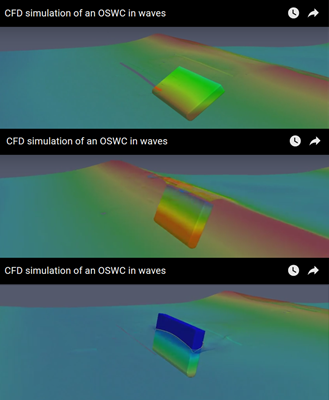Wave Energy
The development of wave energy has been a major focus of the Marine Research Group at QUB since the 1970’s. The Group have been responsible for the research behind 7 different prototype wave power devices, which have been successfully tested at sea. This commercially focussed research continues to this day. The MRG operate two wave tank facilities for small scale modelling of all aspects of Wave Energy Converter technology development from concept development, device optimisation, load evaluation and array interaction. Our physical modelling capabilities are complemented with numerical modelling techniques such as computational fluid dynamics.



QUB’s Marine Research Group, working alongside companies such as Aquamarine Power, employ a combination of experimental tank testing, numerical methods and field expertise to improve the understanding of WEC technology.
Research undertaken by the group focusses on the optimisation of power take-off systems, resource assessment, control strategies, shape optimisation, load assessment, deployment methods and array studies.
We have been involved in concept design, development and optimisation for various classes of wave energy converters (WECs) including OWCs such as the LIMPET power plant and more recently Oscillating Wave Surge Converters. Research carried out at QUB lead to the development of the Oyster wave energy device, and in 2005 the company Aquamarine Power was formed to further develop the concept. Aquamarine Power designed built and operated two full scale prototypes Oyster1 (2009) and Oyster800 (2011) at the European Marine Energy Centre in Orkney.
Utilising this knowledge we are now working on development of the next generation WECs
Computational Dynamics: In close cooperation with the experimental tests performed off-shore and in our wave tanks, the Marine Research Group develops, validates and applies OpenFOAM CFD tools to the simulation of WECs.
Our interest focuses on coastal processes, efficient wave generation and absorption methods, fluid structure interaction and moving bodies.
OpenFOAM based tools have successfully been validated for the simulation of bottom hinged wave energy converters and are used to investigate extreme loads, scaling laws and parametric shape variations.
Extreme Loading on WECs One major difficulty in the design of full scale WECs is the need to design for two conflicting design criteria. In one instance devices must be designed to couple heavily to the incident water waves resulting in the efficient extraction of energy in small to moderate sea states. However, devices must also be capable of surviving the harshness of the much less frequent extreme seas. The danger is that the added cost of design for survivability increases the cost of energy produced to the point whereby wave energy is not commercially competitive.
Here at Queen’s we have been looking into the extreme wave loading of pitching flap-type WECs, often referred to as Oscillating Wave Surge Converters (OWSCs). For large, buoyant, surface-piercing OWSCs such as the Aquamarine Power Oyster device the predominant impulsive loading mechanism is slamming, a phenomenon where the device gets fully submerged by a passing wave crest and upon its release gets accelerated into the oncoming wave trough. See the videos below.
The aim of the present course of research is to determine the hydro-mechanical couplings driving the slamming phenomenon and to better inform the future design of OWSCs through a phenomenological investigation of the design space. The research is conducted primarily through physical wave tank testing completed here at QUB and is supplemented by CFD analyses completed using OpenFOAM.
